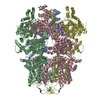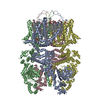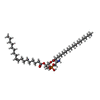[English] 日本語
 Yorodumi
Yorodumi- EMDB-44102: Cryo-EM structure of the mouse TRPM3 alpha 2 channel in complex w... -
+ Open data
Open data
- Basic information
Basic information
| Entry |  | |||||||||
|---|---|---|---|---|---|---|---|---|---|---|
| Title | Cryo-EM structure of the mouse TRPM3 alpha 2 channel in complex with the neurosteroid pregnenolone sulfate and the synthetic agonist CIM 0216 | |||||||||
 Map data Map data | The final full map with global sharpening at B-factor -25 | |||||||||
 Sample Sample |
| |||||||||
 Keywords Keywords | Transient receptor potential channel / TRPM3 / neurosteroid / pregnenolone sulfate / neurodevelopmental disorders / anticonvulsant / primidone / neurological disorders / nociception / analgesic / TRANSPORT PROTEIN | |||||||||
| Function / homology |  Function and homology information Function and homology informationzinc ion transmembrane transporter activity / zinc ion transmembrane transport / temperature-gated ion channel activity / sodium ion transport / monoatomic cation transport / monoatomic cation channel activity / phosphatidylinositol-4,5-bisphosphate binding / calcium ion transmembrane transport / calcium channel activity / G-protein beta/gamma-subunit complex binding ...zinc ion transmembrane transporter activity / zinc ion transmembrane transport / temperature-gated ion channel activity / sodium ion transport / monoatomic cation transport / monoatomic cation channel activity / phosphatidylinositol-4,5-bisphosphate binding / calcium ion transmembrane transport / calcium channel activity / G-protein beta/gamma-subunit complex binding / protein homotetramerization / calmodulin binding / plasma membrane Similarity search - Function | |||||||||
| Biological species |  | |||||||||
| Method | single particle reconstruction / cryo EM / Resolution: 3.82 Å | |||||||||
 Authors Authors | Yin Y / Park CG / Feng S / Zhang F / Guan Z / Sharma K / Borgnia MJ / Im W / Lee S-Y | |||||||||
| Funding support |  United States, 1 items United States, 1 items
| |||||||||
 Citation Citation |  Journal: Nat Struct Mol Biol / Year: 2025 Journal: Nat Struct Mol Biol / Year: 2025Title: Molecular basis of neurosteroid and anticonvulsant regulation of TRPM3. Authors: Ying Yin / Cheon-Gyu Park / Shasha Feng / Ziqiang Guan / Hyuk-Joon Lee / Feng Zhang / Kedar Sharma / Mario J Borgnia / Wonpil Im / Seok-Yong Lee /  Abstract: Transient receptor potential channel subfamily M member 3 (TRPM3) is a Ca-permeable cation channel activated by the neurosteroid pregnenolone sulfate (PregS) or heat, serving as a nociceptor in the ...Transient receptor potential channel subfamily M member 3 (TRPM3) is a Ca-permeable cation channel activated by the neurosteroid pregnenolone sulfate (PregS) or heat, serving as a nociceptor in the peripheral sensory system. Recent discoveries of autosomal dominant neurodevelopmental disorders caused by gain-of-function mutations in TRPM3 highlight its role in the central nervous system. Notably, the TRPM3 inhibitor primidone, an anticonvulsant, has proven effective in treating patients with TRPM3-linked neurological disorders and in mouse models of thermal nociception. However, our understanding of neurosteroids, inhibitors and disease mutations on TRPM3 is limited. Here we present cryogenic electron microscopy structures of the mouse TRPM3 in complex with cholesteryl hemisuccinate, primidone and PregS with the synthetic agonist CIM 0216. Our studies identify the binding sites for the neurosteroid, synthetic agonist and inhibitor and offer insights into their effects and disease mutations on TRPM3 gating, aiding future drug development. | |||||||||
| History |
|
- Structure visualization
Structure visualization
| Supplemental images |
|---|
- Downloads & links
Downloads & links
-EMDB archive
| Map data |  emd_44102.map.gz emd_44102.map.gz | 63.4 MB |  EMDB map data format EMDB map data format | |
|---|---|---|---|---|
| Header (meta data) |  emd-44102-v30.xml emd-44102-v30.xml emd-44102.xml emd-44102.xml | 22.6 KB 22.6 KB | Display Display |  EMDB header EMDB header |
| FSC (resolution estimation) |  emd_44102_fsc.xml emd_44102_fsc.xml | 11.9 KB | Display |  FSC data file FSC data file |
| Images |  emd_44102.png emd_44102.png | 87 KB | ||
| Filedesc metadata |  emd-44102.cif.gz emd-44102.cif.gz | 7.9 KB | ||
| Others |  emd_44102_half_map_1.map.gz emd_44102_half_map_1.map.gz emd_44102_half_map_2.map.gz emd_44102_half_map_2.map.gz | 115.6 MB 115.6 MB | ||
| Archive directory |  http://ftp.pdbj.org/pub/emdb/structures/EMD-44102 http://ftp.pdbj.org/pub/emdb/structures/EMD-44102 ftp://ftp.pdbj.org/pub/emdb/structures/EMD-44102 ftp://ftp.pdbj.org/pub/emdb/structures/EMD-44102 | HTTPS FTP |
-Validation report
| Summary document |  emd_44102_validation.pdf.gz emd_44102_validation.pdf.gz | 940.2 KB | Display |  EMDB validaton report EMDB validaton report |
|---|---|---|---|---|
| Full document |  emd_44102_full_validation.pdf.gz emd_44102_full_validation.pdf.gz | 939.8 KB | Display | |
| Data in XML |  emd_44102_validation.xml.gz emd_44102_validation.xml.gz | 19.3 KB | Display | |
| Data in CIF |  emd_44102_validation.cif.gz emd_44102_validation.cif.gz | 24.8 KB | Display | |
| Arichive directory |  https://ftp.pdbj.org/pub/emdb/validation_reports/EMD-44102 https://ftp.pdbj.org/pub/emdb/validation_reports/EMD-44102 ftp://ftp.pdbj.org/pub/emdb/validation_reports/EMD-44102 ftp://ftp.pdbj.org/pub/emdb/validation_reports/EMD-44102 | HTTPS FTP |
-Related structure data
| Related structure data |  9b2aMC  9b28C  9b29C M: atomic model generated by this map C: citing same article ( |
|---|---|
| Similar structure data | Similarity search - Function & homology  F&H Search F&H Search |
- Links
Links
| EMDB pages |  EMDB (EBI/PDBe) / EMDB (EBI/PDBe) /  EMDataResource EMDataResource |
|---|
- Map
Map
| File |  Download / File: emd_44102.map.gz / Format: CCP4 / Size: 125 MB / Type: IMAGE STORED AS FLOATING POINT NUMBER (4 BYTES) Download / File: emd_44102.map.gz / Format: CCP4 / Size: 125 MB / Type: IMAGE STORED AS FLOATING POINT NUMBER (4 BYTES) | ||||||||||||||||||||||||||||||||||||
|---|---|---|---|---|---|---|---|---|---|---|---|---|---|---|---|---|---|---|---|---|---|---|---|---|---|---|---|---|---|---|---|---|---|---|---|---|---|
| Annotation | The final full map with global sharpening at B-factor -25 | ||||||||||||||||||||||||||||||||||||
| Projections & slices | Image control
Images are generated by Spider. | ||||||||||||||||||||||||||||||||||||
| Voxel size | X=Y=Z: 1.08 Å | ||||||||||||||||||||||||||||||||||||
| Density |
| ||||||||||||||||||||||||||||||||||||
| Symmetry | Space group: 1 | ||||||||||||||||||||||||||||||||||||
| Details | EMDB XML:
|
-Supplemental data
-Half map: Half map A
| File | emd_44102_half_map_1.map | ||||||||||||
|---|---|---|---|---|---|---|---|---|---|---|---|---|---|
| Annotation | Half map A | ||||||||||||
| Projections & Slices |
| ||||||||||||
| Density Histograms |
-Half map: Half map B
| File | emd_44102_half_map_2.map | ||||||||||||
|---|---|---|---|---|---|---|---|---|---|---|---|---|---|
| Annotation | Half map B | ||||||||||||
| Projections & Slices |
| ||||||||||||
| Density Histograms |
- Sample components
Sample components
-Entire : Transient receptor potential cation channel subfamily M member 3
| Entire | Name: Transient receptor potential cation channel subfamily M member 3 |
|---|---|
| Components |
|
-Supramolecule #1: Transient receptor potential cation channel subfamily M member 3
| Supramolecule | Name: Transient receptor potential cation channel subfamily M member 3 type: complex / ID: 1 / Parent: 0 / Macromolecule list: #1 |
|---|---|
| Source (natural) | Organism:  |
-Macromolecule #1: Transient receptor potential cation channel, subfamily M, member 3
| Macromolecule | Name: Transient receptor potential cation channel, subfamily M, member 3 type: protein_or_peptide / ID: 1 / Number of copies: 4 / Enantiomer: LEVO |
|---|---|
| Source (natural) | Organism:  |
| Molecular weight | Theoretical: 198.674297 KDa |
| Recombinant expression | Organism:  Homo sapiens (human) Homo sapiens (human) |
| Sequence | String: MGKKWRDAGE LERGCSDRED SAESRRRSRS ASRGRFAESW KRLSSKQGST KRSGLPAQQT PAQKSWIERA FYKRECVHII PSTKDPHRC CCGRLIGQHV GLTPSISVLQ NEKNESRLSR NDIQSEKWSI SKHTQLSPTD AFGTIEFQGG GHSNKAMYVR V SFDTKPDL ...String: MGKKWRDAGE LERGCSDRED SAESRRRSRS ASRGRFAESW KRLSSKQGST KRSGLPAQQT PAQKSWIERA FYKRECVHII PSTKDPHRC CCGRLIGQHV GLTPSISVLQ NEKNESRLSR NDIQSEKWSI SKHTQLSPTD AFGTIEFQGG GHSNKAMYVR V SFDTKPDL LLHLMTKEWQ LELPKLLISV HGGLQNFELQ PKLKQVFGKG LIKAAMTTGA WIFTGGVNTG VIRHVGDALK DH ASKSRGK ICTIGIAPWG IVENQEDLIG RDVVRPYQTM SNPMSKLTVL NSMHSHFILA DNGTTGKYGA EVKLRRQLEK HIS LQKINT RIGQGVPVVA LIVEGGPNVI SIVLEYLRDT PPVPVVVCDG SGRASDILAF GHKYSEEGGL INESLRDQLL VTIQ KTFTY TRTQAQHLFI ILMECMKKKE LITVFRMGSE GHQDIDLAIL TALLKGANAS APDQLSLALA WNRVDIARSQ IFIYG QQWP VGSLEQAMLD ALVLDRVDFV KLLIENGVSM HRFLTISRLE ELYNTRHGPS NTLYHLVRDV KKGNLPPDYR ISLIDI GLV IEYLMGGAYR CNYTRKRFRT LYHNLFGPKR PKALKLLGME DDIPLRRGRK TTKKREEEVD IDLDDPEINH FPFPFHE LM VWAVLMKRQK MALFFWQHGE EAMAKALVAC KLCKAMAHEA SENDMVDDIS QELNHNSRDF GQLAVELLDQ SYKQDEQL A MKLLTYELKN WSNATCLQLA VAAKHRDFIA HTCSQMLLTD MWMGRLRMRK NSGLKVILGI LLPPSILSLE FKNKDDMPY MTQAQEIHLQ EKEPEEPEKP TKEKDEEDME LTAMLGRSNG ESSRKKDEEE VQSRHRLIPV GRKIYEFYNA PIVKFWFYTL AYIGYLMLF NYIVLVKMER WPSTQEWIVI SYIFTLGIEK MREILMSEPG KLLQKVKVWL QEYWNVTDLI AILLFSVGMI L RLQDQPFR SDGRVIYCVN IIYWYIRLLD IFGVNKYLGP YVMMIGKMMI DMMYFVIIML VVLMSFGVAR QAILFPNEEP SW KLAKNIF YMPYWMIYGE VFADQIDPPC GQNETREDGK TIQLPPCKTG AWIVPAIMAC YLLVANILLV NLLIAVFNNT FFE VKSISN QVWKFQRYQL IMTFHERPVL PPPLIIFSHM TMIFQHVCCR WRKHESDQDE RDYGLKLFIT DDELKKVHDF EEQC IEEYF REKDDRFNSS NDERIRVTSE RVENMSMRLE EVNEREHSMK ASLQTVDIRL AQLEDLIGRM ATALERLTGL ERAES NKIR SRTSSDCTDA AYIVRQSSFN SQEGNTFKLQ ESIDPAGEET ISPTSPTLMP RMRSHSFYSV NVKDKGGIEK LESIFK ERS LSLHRATSSH SVAKEPKAPA APANTLAIVP DSRRPSSCID IYVSAMDELH CDIEPLDNSM NILGLGEPSF SALAPST TP SSSAYATLAP TDRPPSRSID FEDLTSMDTR SFSSDYTHLP ECQNPWDTDP PTYHTIERSK SSRYLATTPF LLEEAPIV K SHSFMFSPSR SYYANFGVPV KTAEYTSITD CIDTRCVNAP QAIADRATFP GGLGDKVEDL SCCHPEREAE LSHPSSDSE ENEARGQRAA NPISSQEAEN ADRTLSNNIT VPKIERANSY SAEEPNVPYA HTRKSFSISD KLDRQRNTAS LRNPFQRSKS SKPEGRGDS LSMRRLSRTS AFHSFESKHN SNSLEVLFQG PDYKDDDDKA HHHHHHHHHH UniProtKB: Transient receptor potential cation channel subfamily M member 3 |
-Macromolecule #2: (2S)-2-(3,4-dihydroquinolin-1(2H)-yl)-N-(5-methyl-1,2-oxazol-3-yl...
| Macromolecule | Name: (2S)-2-(3,4-dihydroquinolin-1(2H)-yl)-N-(5-methyl-1,2-oxazol-3-yl)-2-phenylacetamide type: ligand / ID: 2 / Number of copies: 4 / Formula: A1AIB |
|---|---|
| Molecular weight | Theoretical: 347.41 Da |
-Macromolecule #3: [(2~{R})-1-[2-azanylethoxy(oxidanyl)phosphoryl]oxy-3-hexadecanoyl...
| Macromolecule | Name: [(2~{R})-1-[2-azanylethoxy(oxidanyl)phosphoryl]oxy-3-hexadecanoyloxy-propan-2-yl] (~{Z})-octadec-9-enoate type: ligand / ID: 3 / Number of copies: 4 / Formula: 6OU |
|---|---|
| Molecular weight | Theoretical: 717.996 Da |
| Chemical component information |  ChemComp-6OU: |
-Macromolecule #4: Pregnenolone sulfate
| Macromolecule | Name: Pregnenolone sulfate / type: ligand / ID: 4 / Number of copies: 4 / Formula: A8W |
|---|---|
| Molecular weight | Theoretical: 396.541 Da |
| Chemical component information |  ChemComp-A8W: |
-Experimental details
-Structure determination
| Method | cryo EM |
|---|---|
 Processing Processing | single particle reconstruction |
| Aggregation state | particle |
- Sample preparation
Sample preparation
| Buffer | pH: 8 |
|---|---|
| Grid | Model: Quantifoil R1.2/1.3 / Material: COPPER / Mesh: 300 / Support film - Material: CARBON / Support film - topology: CONTINUOUS / Support film - Film thickness: 2 / Pretreatment - Type: GLOW DISCHARGE |
| Vitrification | Cryogen name: ETHANE / Chamber humidity: 100 % / Chamber temperature: 293.15 K / Instrument: FEI VITROBOT MARK IV |
- Electron microscopy
Electron microscopy
| Microscope | FEI TITAN KRIOS |
|---|---|
| Specialist optics | Energy filter - Name: GIF Bioquantum / Energy filter - Slit width: 20 eV |
| Image recording | Film or detector model: GATAN K3 BIOQUANTUM (6k x 4k) / Number grids imaged: 1 / Number real images: 8390 / Average electron dose: 60.0 e/Å2 |
| Electron beam | Acceleration voltage: 300 kV / Electron source:  FIELD EMISSION GUN FIELD EMISSION GUN |
| Electron optics | C2 aperture diameter: 70.0 µm / Illumination mode: FLOOD BEAM / Imaging mode: BRIGHT FIELD / Cs: 2.7 mm / Nominal defocus max: 2.2 µm / Nominal defocus min: 0.7000000000000001 µm / Nominal magnification: 81000 |
| Sample stage | Specimen holder model: FEI TITAN KRIOS AUTOGRID HOLDER / Cooling holder cryogen: NITROGEN |
| Experimental equipment |  Model: Titan Krios / Image courtesy: FEI Company |
+ Image processing
Image processing
-Atomic model buiding 1
| Refinement | Space: REAL / Protocol: RIGID BODY FIT |
|---|---|
| Output model |  PDB-9b2a: |
 Movie
Movie Controller
Controller





 Z (Sec.)
Z (Sec.) Y (Row.)
Y (Row.) X (Col.)
X (Col.)





































